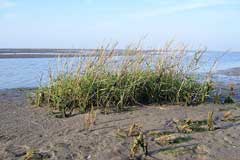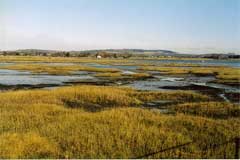 |
|
http://de.wikipedia.org/wiki/Benutzer:Godewind |
 |
| http://commons.wikimedia.org/wiki/User:Neumeier |
Translate this page:
Summary
Physical Characteristics

 Spartina anglica is a PERENNIAL growing to 1.3 m (4ft 3in). The species is monoecious (individual flowers are either male or female, but both sexes can be found on the same plant) and is pollinated by Wind.
Spartina anglica is a PERENNIAL growing to 1.3 m (4ft 3in). The species is monoecious (individual flowers are either male or female, but both sexes can be found on the same plant) and is pollinated by Wind.
Suitable for: light (sandy), medium (loamy) and heavy (clay) soils. Suitable pH: mildly acid, neutral and basic (mildly alkaline) soils and can grow in saline soils.
It can grow in semi-shade (light woodland) or no shade. It prefers moist or wet soil.
UK Hardiness Map
US Hardiness Map
Synonyms
Plant Habitats
Bog Garden;
Edible Uses
References More on Edible Uses
Medicinal Uses
Plants For A Future can not take any responsibility for any adverse effects from the use of plants. Always seek advice from a professional before using a plant medicinally.
None known
References More on Medicinal Uses
The Bookshop: Edible Plant Books
Our Latest books on Perennial Plants For Food Forests and Permaculture Gardens in paperback or digital formats.

Edible Tropical Plants
Food Forest Plants for Hotter Conditions: 250+ Plants For Tropical Food Forests & Permaculture Gardens.
More

Edible Temperate Plants
Plants for Your Food Forest: 500 Plants for Temperate Food Forests & Permaculture Gardens.
More

More Books
PFAF have eight books available in paperback and digital formats. Browse the shop for more information.
Shop Now
Other Uses
Soil stabilization
The plants have an extensive root system and can be used for soil stabilization along rivers and marshes[200].
Special Uses
References More on Other Uses
Cultivation details
Succeeds in fresh or salt water marshes and in ordinary garden soil[162]. Prefers a deep rich moist soil in sun or light shade[200]. Although said to be native to Britain, this species is not in the British Flora[17], though it is in Flora Europaea[50].
References Carbon Farming Information and Carbon Sequestration Information
Temperature Converter
Type a value in the Celsius field to convert the value to Fahrenheit:
Fahrenheit:
The PFAF Bookshop
Plants For A Future have a number of books available in paperback and digital form. Book titles include Edible Plants, Edible Perennials, Edible Trees,Edible Shrubs, Woodland Gardening, and Temperate Food Forest Plants. Our new book is Food Forest Plants For Hotter Conditions (Tropical and Sub-Tropical).
Shop Now
Plant Propagation
Seed - sow in a greenhouse in spring and only just cover the seed. Germination should take place within 2 weeks. Prick out the seedlings into individual pots when they are large enough to handle. Plant out in the summer if sufficient growth has been made, otherwise overwinter them in a cold frame and plant them out in the following spring. Division in spring.
Other Names
If available other names are mentioned here
Common cordgrass.
English: English cordgrass.
Australia: rice grass.
Finland: englanninmarskiheinä.
Germany: Englisches Schlickgras.
Netherlands: engels slijkgras.
Native Range
EUROPE: Denmark, United Kingdom (England (south)), Ireland, Belgium, Germany, Netherlands, France
Weed Potential
Right plant wrong place. We are currently updating this section.
Please note that a plant may be invasive in one area but may not in your area so it's worth checking.
Introduced in some areas for coastal erosion control Spartina anglica (Common Cord-grass) has become an invasive species throughout the British Isles, Asia (China), Australia (South Australia, Tasmania), Europe (Denmark, France, Germany, Netherlands) New Zealand and North America (Canada, USA), causing extensive damage to natural saltmarsh ecosystems in all areas. Invasiveness:
Abundant in its native range,
Fast growing,
Highly mobile locally,
Invasive in its native range,
Long lived,
Pioneering in disturbed areas,
Proved invasive outside its native range,
Reproduces asexually,
Tolerates, or benefits from, cultivation, browsing pressure, mutilation, fire etc. It is highly unlikely that further intentional introductions will be undertaken; due to the knowledge of the invasiveness of S. anglica and that it is now a notified weed in many countries [1d].
Conservation Status
IUCN Red List of Threatened Plants Status : This taxon has not yet been assessed.

Growth: S = slow M = medium F = fast. Soil: L = light (sandy) M = medium H = heavy (clay). pH: A = acid N = neutral B = basic (alkaline). Shade: F = full shade S = semi-shade N = no shade. Moisture: D = dry M = Moist We = wet Wa = water.
Now available:
Food Forest Plants for Mediterranean Conditions
350+ Perennial Plants For Mediterranean and Drier Food Forests and Permaculture Gardens.
[Paperback and eBook]
This is the third in Plants For A Future's series of plant guides for food forests tailored to
specific climate zones. Following volumes on temperate and tropical ecosystems, this book focuses
on species suited to Mediterranean conditions—regions with hot, dry summers and cool, wet winters,
often facing the added challenge of climate change.
Read More
Expert comment
Author
C.Hubb.
Botanical References
17
Links / References
For a list of references used on this page please go here
Readers comment
| Add a comment |
|
If you have important information about this plant that may help other users please add a comment or link below. Only comments or links that are felt to be directly relevant to a plant will be included. If you think a comment/link or information contained on this page is inaccurate or misleading we would welcome your feedback at [email protected]. If you have questions about a plant please use the Forum on this website as we do not have the resources to answer questions ourselves.
* Please note: the comments by website users are not necessarily those held by PFAF and may give misleading or inaccurate information.
To leave a comment please Register or login here All comments need to be approved so will not appear immediately.
|
Subject : Spartina anglica
|
|
|
|